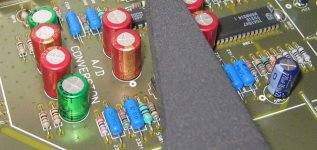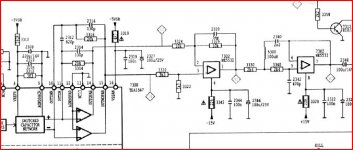Greg3333 said:For bypassing the op-amps, how critical is the cap value? I have some 0.47u/100v to hand - are these too small?
Thanks
Greg
Do you really need the caps? If your DC offset is less than 25mV you should think about leaving them away. This really improves the sound. If not, you could look at some BG caps, prefferably the HI Q N caps. They are preffered for DC decoupling. I know BG caps are not cheap, but the HI Q N caps 47uF 6,3V are only about 2,30 euro in Holland. And because you only need 2 of them I think the costs are less than the bennefit.
yeah sorry heres the link again its the cerafine caps 100uf/35v but he does say he can get more values http://cgi.ebay.co.uk/ws/eBayISAPI....MESE:IT&viewitem=&item=260108856495&rd=1&rd=1
Elna Cerafine & Silmic - also see here.
Bypassing op-amps - I think it's only really beneficial with high-speed op-amps. Those with high gain-bandwidth product (say 50Mhz and up) and high slew-rate.
Assuming you mean connecting the cap from pin 4 to pin 8 of the op-amp.
Huge benefit for LM6172 (goes from awful to superb), did diddly-squat on the Burr-Brown slow-pokes.
Try it with and without and see which you prefer.
A good low-inductance cap (like stacked film or ceramic) is needed to tame fast chips like LM6172. Search for EPCOS B32560 as an example. I use values from 0.1uF to 1uF with success.
LM6172, AD826 and LT1364 are three that benefitted from 1uF stacked film. I posted on this a few pages back so there's more info on them back there.
Hope this helps.
Bypassing op-amps - I think it's only really beneficial with high-speed op-amps. Those with high gain-bandwidth product (say 50Mhz and up) and high slew-rate.
Assuming you mean connecting the cap from pin 4 to pin 8 of the op-amp.
Huge benefit for LM6172 (goes from awful to superb), did diddly-squat on the Burr-Brown slow-pokes.
Try it with and without and see which you prefer.
A good low-inductance cap (like stacked film or ceramic) is needed to tame fast chips like LM6172. Search for EPCOS B32560 as an example. I use values from 0.1uF to 1uF with success.
LM6172, AD826 and LT1364 are three that benefitted from 1uF stacked film. I posted on this a few pages back so there's more info on them back there.
Hope this helps.
heap shame and ridicule on me! (see if I care) past the 150 hr mark the LM4562 get even better: sweeter, more expansive. I implore anyone using these to WAIT before passing judgement.
AVR, any change in the AD8599?
Also, when an opamp (e.g. NE5532) oscillates, what does it sound like? A hum can be this?
Also, when an opamp (e.g. NE5532) oscillates, what does it sound like? A hum can be this?
An unexpected benefit of these opamps, for which I have no explanation, is that they seem somehow to restrain my Trends T-amp from clipping so easily, and when it does so, more gracefully.
This is very obvious because the T amps do not sound nice when they clip and I've had to live with that for months and keep the vol. down more than I like. If the op's mellow even more I will be in Audio bliss!
This is very obvious because the T amps do not sound nice when they clip and I've had to live with that for months and keep the vol. down more than I like. If the op's mellow even more I will be in Audio bliss!
Malefoda said:AVR, any change in the AD8599?
Busy playing on my new baby - a DAC7 Philips CD950 with CDM9/44 mech. Pretty cool in standard trim but there will be a Flea flying 'round soon.
So it's long time ago since I have heard the CD63.
Attachments
avr300 said:Busy playing on my new baby - a DAC7 Philips CD950 with CDM9/44 mech. Pretty cool in standard trim but there will be a Flea flying 'round soon.
So it's long time ago since I have heard the CD63.
Hey, this DAC has external connections to the DAC's output pins 🙂
Excellent candidate for a passive filter + discrete output stage

Ray
6h5c said:
Hey, this DAC has external connections to the DAC's output pins 🙂
Excellent candidate for a passive filter + discrete output stage
Ray
Yes, it's made like this.
Attachments
Glenn2 said:AD826 rarely gets a mention. Single version is AD817.
It's fast, with a high slew rate and the quickest settling time of them all. PSRR is worse than many and it needs a cap across +V/-V to sound its best. I used the 1uF/100V stacked films I was talking about earlier.
It has a very detailed sound with very clean HF. The mids are very detailed and the image is very broad. Bass is deep and tight. Never gets confused.
It's a bit like a bi-polar version of the AD825 internally.
It lacks a bit of warmth and mid-bass punch compared to the AD825 but is cleaner in the highs.
You have to be careful where you use it, as it draws huge bias currents through its inputs. You can end up with enormous DC offsets in some circuits. You wouldn't use it in a headphone amp or you might cook your cans. I tried it in my old pre-amp once and the DC-coupled input meant you'd get a rumble as you turned the volume pot.
In the CD63/67 filter the bias currents are equalised (assuming reasonable matching of the resistors) but it's always worth checking. You can easily find an extra 20mV appears on the output.
It's one of the better ones.
But yes, they all do one thing better than each other and that's why I want to try the discrete stage. I think much of the negative effects of the op-amp that we hear are down to the huge amounts of feedback.
Hi Glenn,
I have been using the ad826 in my cd 63, in fact i like it compare to the lm4562(just a personal preference) what u showed about stacking the 1uf/100v, what improvement is noted.
In fact I was planning to put the ad826 on my headamp until i see your post on cooking the phones. Is it really impossible to use it on a head amp.
Regards,
Marcus
Hi Marcus,
Only time for a quick post as I'm heading out....
It depends on your circuit. It maya have been designed for FET input op-amps, it may be cap-coupled.
You could try them and measure the DC offset at the output witout the phones connected. Be sure to see if this changes with the position of the volume control too. Compare to your normal op-amp.
The cap on the AD826 sweetened the highs and made it a little less sharp. Not night and day, but i felt it sounded cleaner and was worthwhile. (On the LM6172 it is much more beneficial.)
Only time for a quick post as I'm heading out....
It depends on your circuit. It maya have been designed for FET input op-amps, it may be cap-coupled.
You could try them and measure the DC offset at the output witout the phones connected. Be sure to see if this changes with the position of the volume control too. Compare to your normal op-amp.
The cap on the AD826 sweetened the highs and made it a little less sharp. Not night and day, but i felt it sounded cleaner and was worthwhile. (On the LM6172 it is much more beneficial.)
YoungSC said:Does anyone know the maximum current each of the 7805's need to put out in the CD67?
avr300 said:1A, since the original player runs on only one 7805.
No, the 67 runs on two 7805's 😀
I don't know the exact current requirement for the player, but if you lift U264 or U268 and put a meter in series you can easily measure the exact value for Q811/Q871. I measured it once through FH11/FH12 and got about 450mA for the whole 5V section.
Are you going to try a passive filter for that Bitstream DAC, avr?
What decoder/filter does the 950 use?
Regards,
Ray
Ups, sorry - assumptions is the worst thing. 


Well, 1A each 😀
SAA7350 -> TDA1547 and this http://www.diyaudio.com/forums/showthread.php?postid=1189840#post1189840
I really need to get hold of an extra for reference, either another 950 or a 930 before touching this - but it's not easy.
Don't hijack your own threat, Ray - must be what's referred to as threat-jitter.



Well, 1A each 😀
SAA7350 -> TDA1547 and this http://www.diyaudio.com/forums/showthread.php?postid=1189840#post1189840
I really need to get hold of an extra for reference, either another 950 or a 930 before touching this - but it's not easy.
Don't hijack your own threat, Ray - must be what's referred to as threat-jitter.
HIJACK IN PROGRESS 😀
So the 7350 is only used for the oversampling then. I know it from the CD72, it sounds very nice. I wonder what it will be like with the 1547 DAC. What is used for the decoder?
Ray
END OF HIJACK 😀
So the 7350 is only used for the oversampling then. I know it from the CD72, it sounds very nice. I wonder what it will be like with the 1547 DAC. What is used for the decoder?
Ray
END OF HIJACK 😀
[topic-skew]
More on this big schematics.... 0.5m wide this original service manual (paper) when folded out.
SAA7310 - decoder
SM5840 - digital filter
[/topic-skew]
More on this big schematics.... 0.5m wide this original service manual (paper) when folded out.
SAA7310 - decoder
SM5840 - digital filter
[/topic-skew]
cd 67
Hi,
Fitted a new psu (toroid + schottkys + smoothing caps) for my clock and split DAC regs at the weekend. Surprisingly it worked 1st time (2nd if you count the time when I forgot to reconnect the mains lead🙂 ).
Have to say, I've not noticed any great improvement though.
Regards
Pete
Hi,
Fitted a new psu (toroid + schottkys + smoothing caps) for my clock and split DAC regs at the weekend. Surprisingly it worked 1st time (2nd if you count the time when I forgot to reconnect the mains lead🙂 ).
Have to say, I've not noticed any great improvement though.
Regards
Pete
- Home
- Source & Line
- Digital Source
- Marantz CD63 & CD67 mods list


